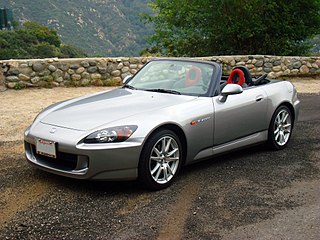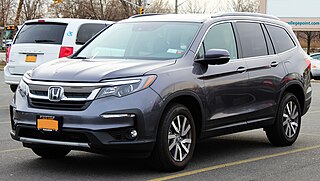Related Research Articles

Acura is the luxury and performance division of Japanese automaker Honda, based primarily in North America. The brand was launched in the United States on March 27, 1986, marketing luxury and performance automobiles. It was introduced to Canada on February 14, 1987, Hong Kong in 1991, Mexico in 2004, China in 2006, Russia in 2014, Panama in 2014, Kuwait in 2015, and was also sold in Ukraine in 2006. Honda's plan to introduce Acura to the Japanese domestic market (JDM) in 2008 was delayed, due to economic reasons, and later withheld as a result of the financial crisis of 2007–2008.
Power-to-weight ratio is a calculation commonly applied to engines and mobile power sources to enable the comparison of one unit or design to another. Power-to-weight ratio is a measurement of actual performance of any engine or power source. It is also used as a measurement of performance of a vehicle as a whole, with the engine's power output being divided by the weight of the vehicle, to give a metric that is independent of the vehicle's size. Power-to-weight is often quoted by manufacturers at the peak value, but the actual value may vary in use and variations will affect performance.

The Honda Accord, also known as the Honda Inspire in Japan and China for certain generations, is a series of cars manufactured by Honda since 1976, best known for its four-door sedan variant, which has been one of the best-selling cars in the United States since 1989. The Accord nameplate has been applied to a variety of vehicles worldwide, including coupes, station wagons, hatchbacks and a Honda Crosstour crossover.

The Honda Insight is a hybrid electric vehicle that is manufactured and marketed by Honda. Its first generation was a two-door, two passenger liftback (1999–2006) and in its second generation was a four-door, five passenger liftback (2009–2014). In its third generation, it became a four-door sedan (2018–2022). It was Honda's first model with Integrated Motor Assist system and the most fuel efficient gasoline-powered car available in the U.S. without plug-in capability — for the length of its production run.

The Acura TL is an executive car that was manufactured by Acura, the luxury division of Honda. It was introduced in 1995 to replace the Acura Vigor and was badged for the Japanese-market from 1996 to 2000 as the Honda Inspire and from 1996 to 2004 as the Honda Saber. The TL was Acura's best-selling model until it was outsold by the MDX in 2007. In 2005, it ranked as the second best-selling luxury sedan in the United States behind the BMW 3 Series, but sales decreased after the 2008 model year. Four generations of the Acura TL were produced, with the final fourth generation TL premiering in 2008 as a 2009 model and ending production in 2014, when it was replaced together with the TSX by the TLX.

The Honda S2000 is an open top sports car that was manufactured by Japanese automobile manufacturer Honda, from 1999 until 2009. First shown as a concept car called the SSM at the Tokyo Motor Show in 1995, the production version was launched on April 15, 1999, to celebrate the company's 50th anniversary. The S2000 is named for its engine displacement of two litres, carrying on in the tradition of the S500, S600, and S800 roadsters of the 1960s.

The Acura RL is a mid-size luxury car that was manufactured by the Acura division of Honda for the 1996–2012 model years over two generations. The RL was the flagship of the marque, having succeeded the Acura Legend, and was replaced in 2013 by the Acura RLX. All models of the Legend, RL and RLX lines have been adapted from the Japanese domestic market Honda Legend. The model name "RL" is an abbreviation for "Refined Luxury."

The Honda Ridgeline is a midsize pickup truck manufactured by Honda. The Ridgeline is the only pickup truck currently produced by Honda. The Ridgeline is built using a unibody frame, a transverse-mounted engine, and is only offered in a crew–cab short-box configuration with one powertrain.

The Honda Pilot is a mid-size crossover SUV with three-row seating manufactured by Honda since 2002. Primarily aimed at the North American market, the Pilot is the largest SUV produced by Honda. Pilots are currently manufactured in Lincoln, Alabama, and the Pilot was produced in Alliston, Ontario until April 2007. The first generation Pilot was released in April 2002 as a 2003 model.

The Honda Passport is a line of sport utility vehicles (SUV) from the Japanese automaker Honda. Originally, it was a badge engineered version of the Isuzu Rodeo, a mid-size SUV sold between 1993 and 2002. It was introduced in 1993 for the 1994 model year as Honda's first entry into the growing SUV market of the 1990s in the United States. The first and second generation Passport was manufactured by Subaru Isuzu Automotive in Lafayette, Indiana. Like various other Honda models, it re-used a name from their motorcycle division, the Honda C75 Passport. The other two name candidates were Elsinore and Odyssey, the latter would be re-used a year later on a minivan.
The Honda CT series was a group of Honda trail bike motorcycles made since 1964. The CT designation is a slight exception in Honda nomenclature in that "CT" does not indicate a series of mechanically related bikes, but rather a group of different bikes that are all for casual off-road use.

An underbone is a type of motorcycle that uses structural tube framing with an overlay of plastic or non-structural body panels and contrasts with monocoque or unibody designs where pressed steel serves both as the vehicle's structure and bodywork. Outside Asia, the term underbone is commonly misunderstood to refer to any lightweight motorcycle that uses the construction type, known colloquially as step-throughs, mopeds or scooters.

The Honda Civic Type R is a series of high-performance hatchback/sedan models based on the Civic, developed and produced by Honda since September 1997. The first Civic Type R was the third model to receive Honda's Type R badge. Type R versions of the Civic typically feature a lightened and stiffened body, specially tuned engine, and upgraded brakes and chassis, and are offered only in five- or six-speed manual transmission. Like other Type R models, red is used in the background of the Honda badge to give it a special sporting distinction and to separate it from other models.

The drag coefficient is a common measure in automotive design as it pertains to aerodynamics. Drag is a force that acts parallel to and in the same direction as the airflow. The drag coefficient of an automobile measures the way the automobile passes through the surrounding air. When automobile companies design a new vehicle they take into consideration the automobile drag coefficient in addition to the other performance characteristics. Aerodynamic drag increases with the square of speed; therefore it becomes critically important at higher speeds. Reducing the drag coefficient in an automobile improves the performance of the vehicle as it pertains to speed and fuel efficiency. There are many different ways to reduce the drag of a vehicle. A common way to measure the drag of the vehicle is through the drag area.

The seventh-generation Honda Civic is an automobile produced by Honda from 2000 until 2005. It debuted in September 2000 as a 2001 model. Its exterior dimensions stayed similar to the outgoing predecessor, with interior space significantly increased, bumping up it up to the compact car size designation. A notable feature was the flat rear floor that gave better comfort to the rear seat passengers. This generation abandoned the front double wishbone suspension, used previously from fourth to sixth generations, replacing it with MacPherson struts. This generation was the last to offer 4WD variants.

The eighth-generation Honda Civic is a range of compact cars (C-segment) manufactured by Honda between 2005 and 2012, replacing the seventh-generation Civic. Four body styles were introduced throughout its production run, which are sedan, coupe, and both three-door and five-door hatchback. The sedan version was introduced with two distinct styling for different markets, with one of them sold as the Acura CSX in Canada and as the Ciimo 1.8 in China from 2012 until 2016. The hatchback versions formed the European-market Civic range, which received a different architecture, body design and smaller footprint, and solely produced in Swindon, United Kingdom.

The North American eighth generation Honda Accord is a mid-size car introduced in August 2007 for the 2008 model year. It is also marketed in parts of Asia and Australasia, and as the Honda Inspire in Japan.

The Honda Crosstour is a mid-size crossover SUV with a sloping rear roofline manufactured by Japanese automaker Honda. It is based on the North American eighth-generation Accord. Sales began in November 2009 for the 2010 model year and were discontinued after the 2015 model year due to slow sales.

The ninth-generation Honda Civic is a range of compact cars (C-segment) manufactured by Honda between 2011 and 2017, replacing the eighth-generation Civic. It was launched in the North American market in April 2011, Europe in February 2012 and Asia-Pacific in early 2012. Four body styles were introduced throughout its production run, which are sedan, coupe, hatchback and a station wagon version marketed as the Civic Tourer. The latter two makes up for the European-market Civic range, which was produced in Swindon, United Kingdom, and received a completely different design and smaller exterior size. The hatchback version forms a basis for a Civic Type R (FK2) model, which was released later in 2015.
The A-Spec and Type-S marques represent the high-performance divisions of cars produced by Acura. Acura utilized the Type R marque for their high-performance division of cars from 1997 to 2001, when they produced the Acura Integra Type R. The first vehicle offered as a Type-S variant was the 2001 Acura CL, and the first vehicle offered as an A-Spec variant was the 2003 Acura TL in Canada and the 2002 Acura RSX in the US.
References
- ↑ "Honda Pilot Specs Page". Off-Road.com. Retrieved 2008-04-03.
- ↑ "Honda Pilot Specs". Off-Road.com. Retrieved 2008-04-03.
- ↑ "Honda Service Manual FL400R Pilot".